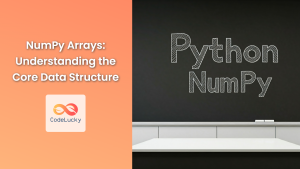NumPy is a cornerstone of Python's data science and machine learning ecosystem. Its powerful array manipulation capabilities, combined with a rich library of mathematical functions, make it indispensable for preprocessing data and crafting features for your models. This article will guide you through essential NumPy techniques for transforming raw data into a format suitable for machine learning algorithms.
Understanding the Importance of Data Preprocessing
Before feeding data into a machine learning model, it's crucial to prepare it. Raw data often contains inconsistencies, missing values, and diverse scales. This can significantly impact model performance and accuracy. NumPy empowers us to efficiently handle these challenges:
- Missing Values: Imputation techniques replace missing data points with estimates, ensuring the model can process complete datasets.
- Scaling: Normalizing data to a common range prevents features with larger scales from dominating others, ensuring fair contributions to the model.
- Encoding: Categorical data, often represented as strings, needs to be converted into numerical formats that algorithms can understand.
- Feature Engineering: NumPy enables the creation of new features from existing data, potentially unlocking hidden relationships and enhancing predictive power.
NumPy for Data Preprocessing: Essential Techniques
This section will cover a wide range of NumPy functions and techniques for data preprocessing.
1. Handling Missing Values: np.nan, np.isnan, np.nan_to_num
Concept: Missing data, often represented by NaN (Not a Number), can disrupt computations and mislead models. NumPy provides tools to identify and handle NaN values effectively.
Syntax:
np.nan: Represents a missing value.np.isnan(array): Returns a boolean array indicatingNaNlocations.np.nan_to_num(array, nan=0, posinf=None, neginf=None): ReplacesNaN, positive infinity, and negative infinity with specified values.
Explanation:
np.nanis a special floating-point value used to represent missing data.np.isnanchecks forNaNvalues within an array.np.nan_to_numlets you replaceNaNwith a desired value, often 0.
Example:
import numpy as np
data = np.array([1, 2, np.nan, 4, 5])
# Check for NaN
has_nan = np.isnan(data)
print(f"Data with NaN: {data}")
print(f"NaN locations: {has_nan}")
# Replace NaN with 0
cleaned_data = np.nan_to_num(data)
print(f"Cleaned data: {cleaned_data}")
Output:
Data with NaN: [ 1. 2. nan 4. 5.]
NaN locations: [False False True False False]
Cleaned data: [1. 2. 0. 4. 5.]
Pitfalls:
- Incorrect Replacement: Replacing
NaNwith an inappropriate value can distort the data distribution. - Ignoring Context: It's essential to consider the context of missing data. Sometimes, removing rows or columns with
NaNmight be more suitable.
2. Data Scaling: np.min, np.max, np.mean, np.std
Concept: Scaling data to a common range (e.g., 0 to 1 or -1 to 1) helps ensure that features with vastly different scales don't unfairly influence the model.
Syntax:
np.min(array): Returns the minimum value in the array.np.max(array): Returns the maximum value in the array.np.mean(array): Calculates the average of the array elements.np.std(array): Computes the standard deviation of the array elements.
Explanation:
- These functions are essential for calculating minimum, maximum, average, and standard deviation values of arrays, vital for scaling techniques.
Example: Min-Max Scaling
import numpy as np
data = np.array([10, 20, 30, 40, 50])
# Min-Max Scaling
min_val = np.min(data)
max_val = np.max(data)
scaled_data = (data - min_val) / (max_val - min_val)
print(f"Scaled data: {scaled_data}")
Output:
Scaled data: [0. 0.25 0.5 0.75 1. ]
Example: Standardization (Z-score)
import numpy as np
data = np.array([10, 20, 30, 40, 50])
# Standardization
mean = np.mean(data)
std = np.std(data)
standardized_data = (data - mean) / std
print(f"Standardized data: {standardized_data}")
Output:
Standardized data: [-1.26491106 -0.63245553 0. 0.63245553 1.26491106]
Pitfalls:
- Data Distribution: Certain scaling methods (e.g., standardization) assume a normal distribution. If the data is heavily skewed, consider other methods.
- Outliers: Outliers can significantly influence the scaling process. It's often advisable to handle outliers before applying scaling.
3. Encoding Categorical Data: np.unique, np.where, np.eye
Concept: Machine learning models typically work with numerical data. Categorical features, represented as strings or labels, need to be converted into numerical equivalents.
Syntax:
np.unique(array, return_counts=True): Finds unique elements and their counts.np.where(condition, x, y): Returns elements fromxwhereconditionisTrue, otherwise fromy.np.eye(N): Creates an identity matrix of size N x N.
Explanation:
- One-Hot Encoding: This popular technique converts categorical values into binary vectors where only one element is 1 (representing the category), and all others are 0.
Example: One-Hot Encoding
import numpy as np
colors = np.array(['red', 'blue', 'green', 'red', 'blue'])
# Find unique colors and their counts
unique_colors, counts = np.unique(colors, return_counts=True)
print(f"Unique colors: {unique_colors}")
print(f"Counts: {counts}")
# Create a one-hot encoding matrix
encoding_matrix = np.eye(len(unique_colors))
print(f"Encoding matrix:\n{encoding_matrix}")
# Convert colors to one-hot encoded vectors
encoded_colors = encoding_matrix[np.where(unique_colors[:, None] == colors)[1]]
print(f"Encoded colors:\n{encoded_colors}")
Output:
Unique colors: ['blue' 'green' 'red']
Counts: [2 1 2]
Encoding matrix:
[[1. 0. 0.]
[0. 1. 0.]
[0. 0. 1.]]
Encoded colors:
[[0. 0. 1.]
[1. 0. 0.]
[0. 1. 0.]
[0. 0. 1.]
[1. 0. 0.]]
Pitfalls:
- Sparse Matrices: One-hot encoding can lead to sparse matrices, potentially affecting model performance. Consider alternatives like label encoding for high-cardinality features.
4. Feature Engineering: np.concatenate, np.expand_dims, np.polyfit, np.sin, np.cos
Concept: NumPy provides the tools to extract new features from existing data, potentially revealing hidden patterns that can improve model accuracy.
Syntax:
np.concatenate((a1, a2, ...), axis=0): Concatenates arrays along a specified axis.np.expand_dims(array, axis=0): Adds a new dimension to the array.np.polyfit(x, y, deg): Fits a polynomial of degreedegto data points(x, y).np.sin(x),np.cos(x): Calculates the sine and cosine of the arrayx.
Explanation:
- Concatenation: Combining arrays allows for creating features by merging different datasets or columns.
- Dimension Expansion: Adding dimensions is crucial for preparing data for certain algorithms like convolutional neural networks.
- Polynomial Regression: Fitting polynomials can capture non-linear relationships in the data.
- Trigonometric Functions: These functions can be used to extract cyclical patterns or create new features based on periodic data.
Example: Creating Interaction Features
import numpy as np
age = np.array([25, 30, 35, 40, 45])
income = np.array([50000, 60000, 70000, 80000, 90000])
# Create an interaction feature
interaction_feature = age * income
print(f"Interaction feature: {interaction_feature}")
Output:
Interaction feature: [ 1250000 1800000 2450000 3200000 4050000]
Example: Polynomial Regression
import numpy as np
import matplotlib.pyplot as plt
x = np.array([1, 2, 3, 4, 5])
y = np.array([2, 4, 6, 8, 10])
# Fit a polynomial of degree 2
coefficients = np.polyfit(x, y, 2)
print(f"Polynomial coefficients: {coefficients}")
# Generate predictions
predicted_y = np.polyval(coefficients, x)
# Plot the original data and the fitted polynomial
plt.scatter(x, y, label="Original Data")
plt.plot(x, predicted_y, label="Polynomial Fit")
plt.legend()
plt.title("Polynomial Regression")
plt.xlabel("x")
plt.ylabel("y")
plt.show()
Output:
Polynomial coefficients: [ 0. 2. 0.]
Pitfalls:
- Feature Explosion: Generating too many features can lead to the curse of dimensionality, where models become less effective with increasing feature space.
- Overfitting: Carefully consider the degree of polynomial fits to avoid overfitting the training data.
NumPy for Machine Learning Feature Engineering: Beyond Preprocessing
NumPy's prowess extends beyond the basics of data preprocessing. Here are some advanced techniques for building powerful features:
- Rolling Window Features: Capture trends or time-series patterns by creating features from consecutive data points.
- Custom Feature Transformations: Define your own functions to apply complex transformations, allowing for tailored feature creation based on specific domain knowledge.
- Sparse Matrix Operations: Leverage NumPy's support for sparse matrices for efficient feature engineering with datasets containing numerous zeros.
Integration with Other Python Libraries
NumPy seamlessly integrates with popular machine learning libraries like Scikit-learn and Pandas:
- Scikit-learn: Use NumPy arrays as input for Scikit-learn's models, making it easy to train and evaluate machine learning algorithms.
- Pandas: Pandas DataFrames often utilize NumPy arrays internally, enabling you to leverage NumPy functions for data manipulation within Pandas workflows.
Conclusion: NumPy's Essential Role in Machine Learning
NumPy is an indispensable tool for machine learning practitioners. Its array manipulation capabilities and mathematical functions make it an efficient platform for preparing data, extracting insightful features, and setting the stage for successful model training. By mastering NumPy's techniques, you gain a powerful arsenal for tackling real-world machine learning challenges.



















